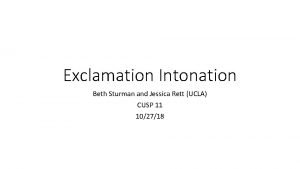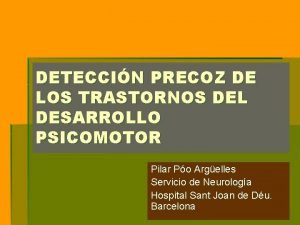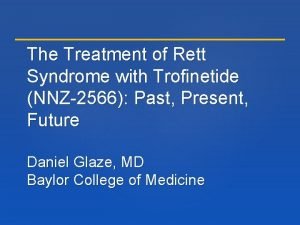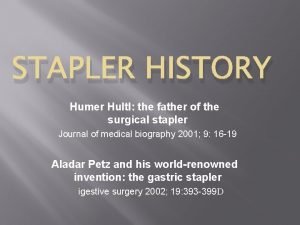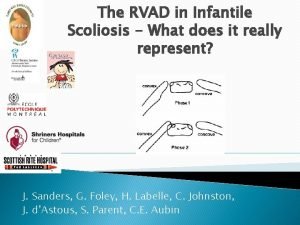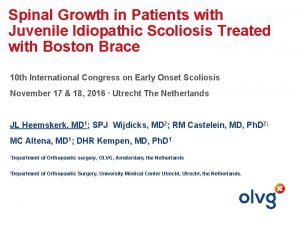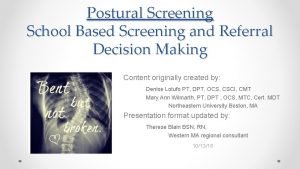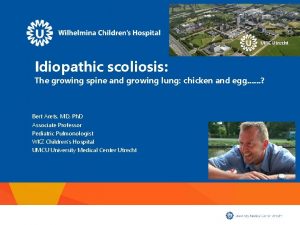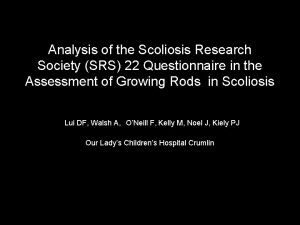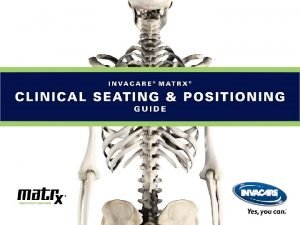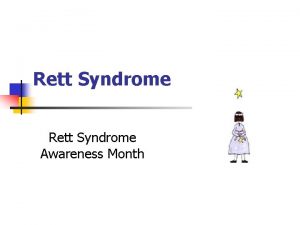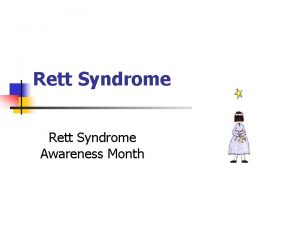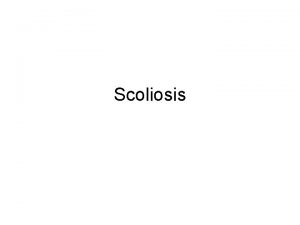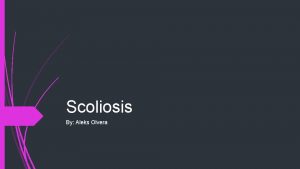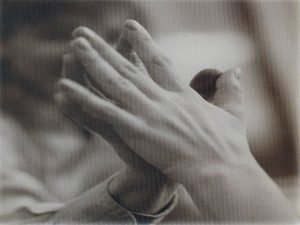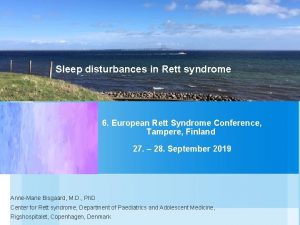Scoliosis in Rett syndrome natural history and surgical











- Slides: 11

Scoliosis in Rett syndrome – natural history and surgical treatment Tomasz Potaczek, MD Barbara Jasiewicz, MD Daniel Zarzycki MD, Ph. D Department of Orthopedic Surgery and Rehabilitation, Faculty Of Medicine, Jagiellonian University, Zakopane, Poland Email: sekretariat@klinika. net. pl, tomaszpotaczek@gmail. com 1

Introduction Rett syndrome (RS) is a rare genetic disorder affecting only girls Mutation of MCEP 2 gene located in chromosome X 1 Prevalence is 1: 15000 1 Diagnosis based on characteristic clinical findings and genetic tests 2 Normal development occurs until 12 -18 months, following that a regression in physical and mental status is typical Orthopedic aspects: scoliosis, contractures, foot deformities, hip luxation 2

Introduction - scoliosis Prevalence of scoliosis in patients with RS varies from 36%-100% of patients depending n the neurological status 3 -5 Typically scoliosis is diagnosed at the age 8 – 10 years, progression may occur despite skeletal maturity 4, 5 Annual curve progression may reach up to 14° -21° 6 Aim of paper Describe the preoperative curve behavior in a series of patients Analyze course of surgery 3 Analyze radiologic parameters Asses subjectively the results

Material 13 girls with RS diagnosis 10 with scoliosis 9 girls treated surgically – study group Age at surgery 11. 7 years (9 -16 years) Follow-up 3. 1 years (1 -6 years) Methods Radiological data (curve type, apical vertebral translation, coronal and sagittal balance) measured pre- and postoperatively Surgical data (type of surgery, course of surgery and early postoperative period) 4 Subjective evaluation (questionnaire handled to caregivers)

Results Basic data: Age of scoliosis onset 9. 3 years (5 -13 years) 8 girls non-ambulant, 1 walking with aid 7 treated with rigid brace, only 2 (22. 2%) compliant Preoperative follow-up 12. 5 months (6 – 24 months) Curve types: 5 Nr Lenke type Curve apex Nr of vertebrae in the curve Ambulant (A)/ Non-ambluant(NA) 1 5 C+ T 12 11 NA 2 5 CN T 12 7 NA 3 1 A+ T 9 9 A 4 5 C+ T 12 10 NA 5 5 C+ L 2 5 NA 6 5 C+ L 1 10 NA 7 5 C+ T 12 11 NA 8 1 A+ T 11 9 A 9 5 C+ T 12 10 NA Girl, S. N. , age 11, 5 CN+ curve type

Results Preoperative change in the radiological parameters: Cobb angle change (°) C 7 -CSVL change (mm) Pelvis inclination Thoracic kyphosis change (°) Mean change 16. 1° 15. 3 mm 7. 1° 12. 6° Range 5 -35° 4 -45 mm -2 -15° -5 -35° Surgical procedure: 6 girls – posterior fusion Galveston technique 1 girl – posterior selective fusion, pelvis not included 2 girls – anterior fusion (1 ambulant) Time of surgery – 126 minutes (100 -250) Blood loss – posterior fusion 650 ml, anterior fusion 250 ml 6 Prolonged mechanical ventilation – 5 girls (24 hours)

Results Surgical procedure 106° 67° Patient P. M. , age at surgery 12 years. Non-ambulant. Posterior fusion Galveston technique, with pedicular screws and hooks. Good result. 7

Results Radiological results: Cobb angle pre-op(°) Cobb angle post-op(°) Correction post-op (%) Correction followup(%) Mean change 85° 54. 1° 38% 33% Range 52 -120° 18 -85° 20 -67% 11 -58% Pre-op Post-op Follow-up Correction follow-up(%) AVT 63. 3 mm 25. 6 mm 26. 7 mm 53. 8% C 7 -CSVL 43. 9 mm 30° 69. 7° 25. 9° 33. 3 mm 10. 7° 45° 22. 4° 25. 6 mm 13° 44° 21. 2° 25. 5% 62. 4% 33. 8% 5. 4% Pelvic inclination T 4 -T 12 kyphosis 8 T 10 -L 2 junction

Results Subjective results: 6 caregivers (66. 7%) agreed to participate in the questionnaire All girls non-ambulant, operated with the same technique Cosmetic efect 5/6 (83. 3%) – very good, 1/6 (16. 7%) – not changed Function 3/6 (50%) – better, 2/6 (33%) – not changed, 1/6 (16. 7%) – worse than preoperatively Recommend surgery 6/6 (100%) – yes 9 Additional remarks 4/6 (66. 7%) – hesitated too long to undergo surgery

Conclusions Curves are usually long-sweeping, but in ambulant patients may resemble idiopathic-like curves Rate of scoliosis progression in patients with Rett syndrome is high The initial curve magnitude is a risk factor of curve progression Deformity may be effectively treated surgically Type of surgery depends on curve type and neurological status There are no major risks of surgery The results of surgery during follow-up period are stable 10

References 1. Amir R. E. , Van den Veyer I. B. , Wan M. : Rett syndrome is caused by mutation in X -linked MECP 2, encoding methyl-Cp. Gbinding protein 2. Nat. Genet. , 1999; 23: 185. 2. Hagberg B. , Hanefeld F. , Percy A. , Skjeldal O. : An update on clinically applicable diagnostic criteria in Rett syndrome. Comments to Rett Syndrome Clinical Criteria Consensus Panel Satellite to European Paediatric Neurology Society Meeting, Baden, Germany, 11 September 2001. Eur. J. Paediatr. Neurol. , 2002; 5: 293 -297. 3. Huang T. J. , Lubicky J. P. , Hammerberg K. W. : Scoliosis in Rett syndrome. Orthop. Rev. , 1994; 23(12): 931 -937. 4. Harrison D. J. , Webb P. J. : Scoliosis in the Rett syndrome: natural history and treatment. Brain Dev. , 1990; 12(1): 154 -156. 5. Kerr A. M. , Webb P. , Prescott R. J. , Milne Y. : Results of surgery for scoliosis in Rett syndrome. J. Child. Neurol. , 2003; 18(10): 703 -708. 6. Lidström J. , Stokland E. , Hagberg B. : Scoliosis in Rett syndrome. Clinical and biological aspects. Spine, 1994; 19(14): 1632 -1635. 11

